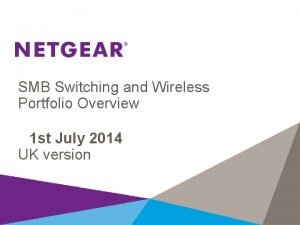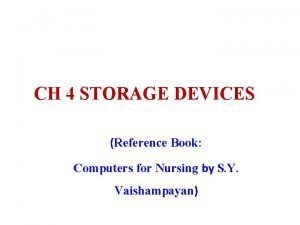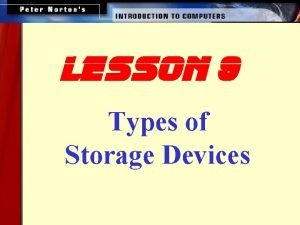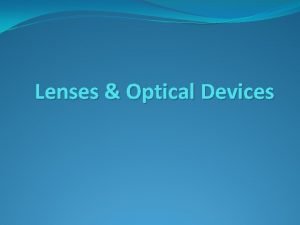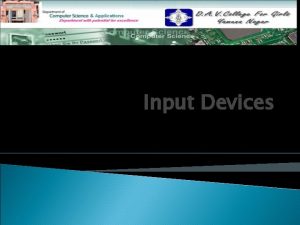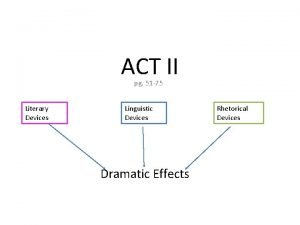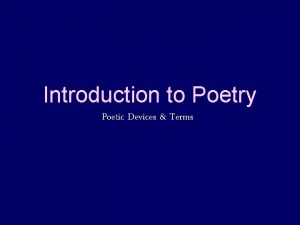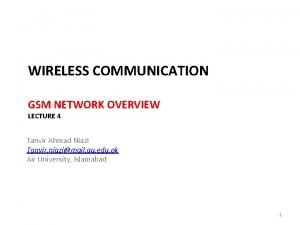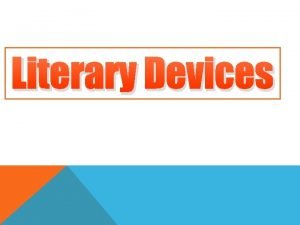Optical Devices An Overview of Terms from Optical













- Slides: 13

Optical Devices An Overview of Terms from Optical Computing

Review of processors • All computer operations can be constructed from series of on/off gates • MOSFET allows “large” current when small voltage applied to gate; no current when no voltage applied to gate • This NON-LINEAR effect is necessary for realistic systems (speed, noise, fan-out) • “Three terminal, ” ie. one signal affects output state

How is Light Better? • FASTER – nothing can travel faster than light in vacuum – Extremely high bandwidth • COOLER (transfer, not nec. processing) – Less loss from scattering as light travels through fibers than electrons through wires • FOURIER TRANSFORMS (clever parallel processing) – Light traveling through a lens performs a Fourier transform automatically

Can Light Do Logic? • Yes - e. g. , the Fabry-Perot interferometer • Need non-linear optical material – material with optical properties (e. g. , index of refraction) depending on intensity – small change in intensity must produce large change in output • Utilize properties of interference and standing waves

Fabry-Perot Interferometer • Ends of cavity like open ends of string: wave not inverted when it is reflected • Standing wave set up if cavity length integer number of half-wavelengths • Can’t just change frequency, since that affects other devices too

More Fabry-Perot Interferometer • Index of refraction determines wavelength • Intensity affects index of refraction • If intensity inside cavity high enough, wavelength will change - from destructive to constructive • This is a resonant process - a large effect occurs very quickly • Can amplify a signal by keeping a constant intensity near the critical value

Advantages of FP • MULTI-FUNCTION - same device can be – AND – low constant signal – need both inputs to produce resonance – OR – medium constant signal - either input strong enough to produce resonance – Amplifier – medium constant signal – small input leads to resonance

Why Aren’t Fabry Perot Devices Front Page Now? • High intensity used to change n also produces heat - materials (usually) expand when heated - throws off interference effect • Can switch on faster than off • Need wide bandgap to operate at room T • BIG!!!

Another Option: Excitons • Hole and electron are attracted, lowering energy in a bound state • Photons emitted when hole and electron pair (exciton) combine has therefore slightly less energy than when hole and electron are not bound • Can maximize this effect by forcing electron and hole into close proximity (quantum well) • Applying a voltage means energies are closer together, but might break bond • Can minimize bond breaking by quantum well

SEEDs • Self-Electro-optic Effect Device (uses feedback) • Set stage: – Shine light of exciton energy on quantum well in middle of p-n junction – Light is absorbed and produces excitons – Apply reverse bias which slightly separates excitons but “significantly” lowers the energy and reduces absorption • If light intensity is increased, absorption increases slightly – can produce more excitons and raise their energy – brings energy back to absorption peak

Pros and Cons of SEEDs • Needs only low power (FP needs high power) • Easier to manufacture – don’t need fine -tuned cavity length • Lower operating speed than FP

Problems with Optical Computers • Using only part-optical computers (i. e. , interconnects) requires adapters • Much research already in semiconductors - hard for light to beat that – Light doesn’t interact because it’s not charged

Before the Next Class • Do Lecture 27 Evaluation by Midnight Friday (why not now? ) • Complete Reading Quiz 28 by Monday • Finish project by Monday
 Client devices portfolio overview
Client devices portfolio overview Polynomial degrees and terms
Polynomial degrees and terms What are the like terms in the algebraic expression
What are the like terms in the algebraic expression Examples of optical storage devices
Examples of optical storage devices Types of optical storage
Types of optical storage Which optical devices spread light apart
Which optical devices spread light apart Scanners input devices
Scanners input devices 75 literary terms elements and devices
75 literary terms elements and devices The mood of a poem
The mood of a poem Definition of input and output devices
Definition of input and output devices Literary techniques example
Literary techniques example Gsm network overview
Gsm network overview Psalms overview
Psalms overview Chapter 17 overview elements and their properties
Chapter 17 overview elements and their properties
